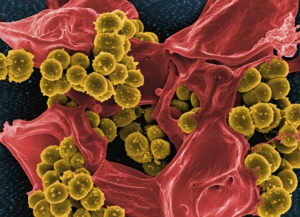Asthma needs to be targeted more specifically
Up to now, researchers believed that lung remodeling follows an autoimmune inflammation triggered by components of the extracellular matrix. In August, British scientists provided a more accurate view of the processes in the lung tissue, opening up a way to optimise failed mid-stage clinical candidates.
According to the team of UK, Spanish, and Polish researchers headed by Dhiren Patel (Manchester), unspecific blocking of the extracellular matrix (ECM) enzyme leukotriene A4 hydrolase (LTA4H), which boosts inflammation by epoxide hydrolysis of LTA4 into the highly proinflammatory lipid mediator leukotrien B4 (LTB4), is not enough to cure asthma (Science Transl. Med., doi: 10.1126/scitranslmed.aaq0693). Actually, several potent LTA4H inhibitors failed to show efficacy at various stages of clinical development, including Johnson & Johnson’s recent Phase II drug candidate JNJ-40929837.
The dual face of LTA4H
In Science Translational Medicine (doi: 10.1126/scitranslmed.aaq0693) they reported outcomes of experiments in a house dust mite model of asthma that prove an overseen second enzymatic activity of LTA4H that interferes with efficacy, a peptidase-binding pocket that overlaps with the hydrolase binding pocket, which binds LTA4 and hydrolyses it into LTB4. Its natural binding partner is PGP (Pro-Gly-Pro), a leukotrien degradation product of the extracellular matrix, which boosts airway sensivity and ECM remodeling when not degraded by LTA4A. PGP is readily degraded during episodes of acute pulmonary inflammation by extracellular LTA4H to facilitate the resolution of neutrophilic inflammation, and failure of this system culminated in augmented and prolonged inflammation with exacerbated pathology and illness. Interestingly, they found PGP accumulation in the sputum of 50 patients with asthma. Significant quantities of PGP have also been found in patients with chronic neutrophilic lung diseases such as chronic obstructive pulmonary disease (COPD), Cystic Fibrosis (CF) and bronchiolitis obliterans syndrome (BOS), peaking with exacerbation of disease and inversely correlating with lung function.
Selective inhibitors already screened
When Patel et al blocked LTA4A activity genetically, they found that inflammation ameliorated due to inhibition of the LTA4 hydrolase activity of LTA4H. However, they also found that remodeling of lung tissue was boosted due to accumulation of PGP, which couldn’t be degraded by the peptidase activity of LTA4H. Docking and structural analysis of LTA4H bound to its three clinically failed inhibitors clearly showed that they blocked PGP from being degraded. In humans, a structural relative of PGP named AcPGP enhanced mucus production and induced airway remodeling when administered to human bronchial cells in culture.
In 2017, the group already reported results from a screening campaign aimed at finding more selective compounds (Sci. Rep., doi: 10.1038/srep44449 (2017). Following reports from Haeggstrom et al in 2014, who identified ARM1 as a potential selective LTA4H inhibitor, with the capacity to inhibit LTB4 generation without perturbing PGP hydrolysis, they initially focused on optimisation of resveratril derivatives. After they found they were not druggable, they switched to isoflavone derivatives and identified a promising candidate. We have developed two distinct chemical series of compounds that can selectively inhibit LTB4 generation with a selectivity that is superior to that of ARM1, the researchers write. These novel compounds could form the basis for the development of selective and safer therapeutics for targeting LTA4H in a broad array of disease modalities.
First published in European Biotechnology Magazine Autumn 2018 edition.




 Genentech Corp. / Roche
Genentech Corp. / Roche